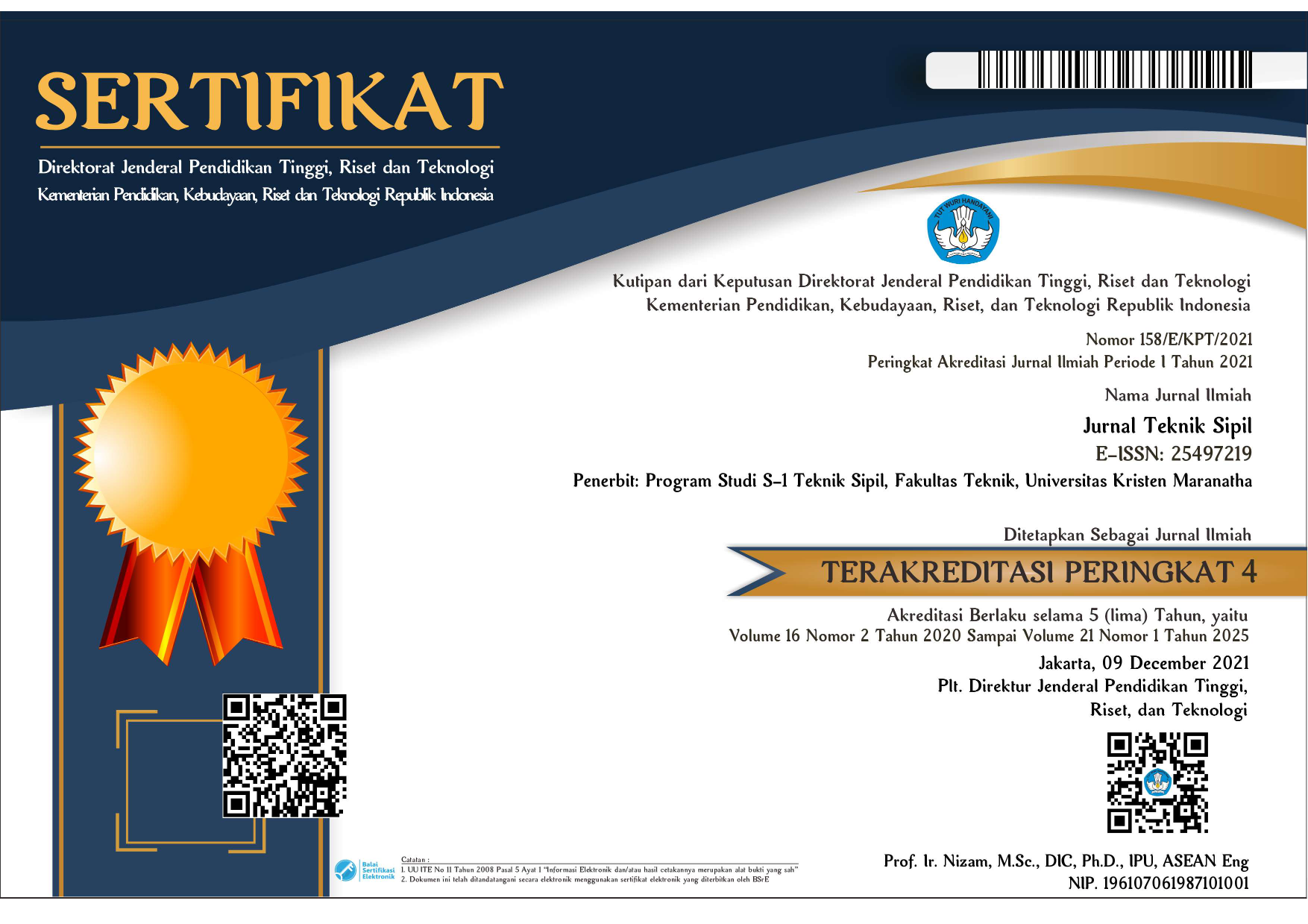Comparative Analysis of Conventional Steel Building Structural Systems and Diagrid Structural Systems with Different Diagonal Member Configurations
DOI:
https://doi.org/10.28932/jts.v20i1.6303Keywords:
High Rise Buildings, Diagrid Structures, Structural Systems, Structural PerformanceAbstract
Diagrid is known as a grid structure where the exterior structure of the building is diagonal, this is one of the most innovative and adaptable approaches and also evolved into its use for high-rise buildings. Diagrid is formed from diagonally shaped frames that are interconnected by materials which can be steel, concrete or wood. The purpose of this study is to determine the performance of the diagrid building structure and how the optimal diagonal member configuration for the diagrid building is. There are 6 types of buildings to be reviewed, consisting of 1 conventional building type and 5 diagrid building types, namely diagrid type 2L20M with diagonal members slope of 33,94°, diagrid type 4L10M with a diagonal angel of 53,39°, diagrid type 8L5M with a diagonal angel of 69,62°, type 10L4M diagrid with a diagonal angle of 73,45° and 20L2M type diagrid with a diagonal angle of 81,55°. The buildings will be analyzed using the ETABS program and following the SNI regulations in Indonesia. The performance result to be compared include cross-sectional dimensions, total structure weight and base shear, service limit performance and time period. The result analysis show that the diagrid building has better structural performance. The diagrid model with the most optimal performance is the 10L4M type with a diagonal member length of 36,51 meters that extends up to 10 floors with a module height of 35 meters and an angle of 73,45°. Diagrid model with the second-best performance is type 8L5M, then in third place is type 4L10M and in fourth place is type 20L2M. The diagrid building with the lowest performance is the 2L20M type which has no better performance than conventional buildings.Downloads
References
Baker, W., Besjak, C., Sarkisian, M., Lee, P., Doo, C. S (2010): Proposed Methodology to Determine Seismic Performance Factors for Steel Diagrid Framed System. U.S. Japan Workshop, 13
Boake, T. M. (2014): The emergence of the diagrid – it’s all about the node. International Journal of High- Rise Buildings, 5, 293 – 304
Manthan, I. Shah (2016): Comparative Study of Diagrid Structures with Conventional Frames Structures. Int. Journal of Engineering Research and Applications, Volume-6, Issue-5 (Part 2)
Moon, K. S. (2009): Design and Construction of Steel Dagrid Structures. NSCC.
Moon, K. S. (2016): Diagrid Structures for Complex Shaped Tall Buildings. Procedia Engineering, 14, 1343 – 1350.
Moon, K. S., Connor, J. J., Fernandez, J. E. (2007): Diagrid Structural System for Tall Building: Characteristic and Methodology for Preliminary Design. The Structural Design of Tall and Special Buildings, 16, 205 – 230
Navasare, Mayur. (2022): Comparative Study of Diagrid System with Conventional Framed Structure. International Research Journal of Engineering and Technology (IRJET), Volume-9 Issue-7
Panchal, N., B. (2014): Optimum Angle of Diagrid Structural System. International Journal of Engineering and Tech
Raghunath, D. Deshpande (2015): Analysis and Comparison of Diagrid and Conventional Structural System. International Research Journal of Engineering and Technology (IRJET), Volume-2, Issue-3
Saputra, D. H., Naibaho, P. R. T. (2019): Efektivitas Sistem Struktur Baja Diagrid Pada Bangunan Tinggi, J. Infras 5(2): 93-98
Varsani, H. (2015): Comparative Analysis of Diagrid Structural System and Conventional Structural System for High Rise Steel Building. International Journal of Advance Research in Engineering, Science & Technology (IJAREST), Volume-2 Issue-1
Vhanmane, M. (2020): Analysis of Diagrid Structural System for High Rise Steel Buildings. Computational Engineering and Physical Modelling, Volume-3 Issue-3
Downloads
Published
How to Cite
Issue
Section
License
Copyright (c) 2024 Bima Candra Nugroho, Relly Andayani

This work is licensed under a Creative Commons Attribution-NonCommercial 4.0 International License.


















